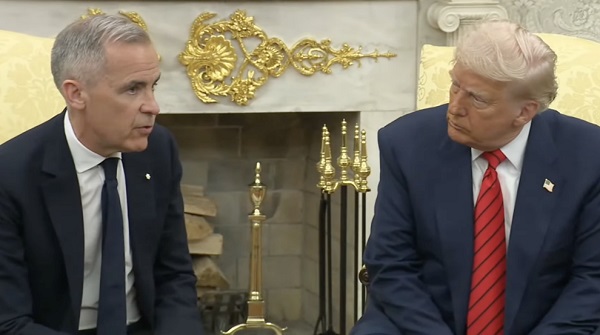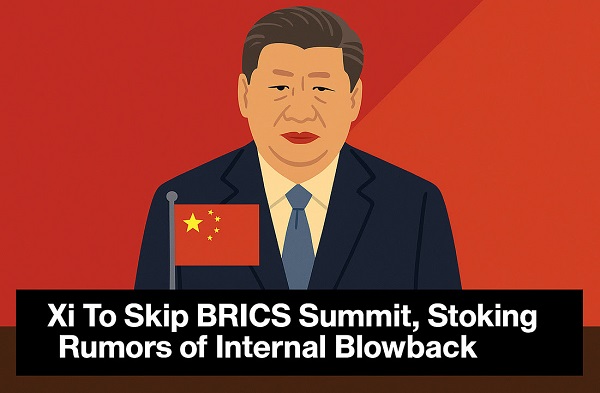Business
Declining Canadian dollar could stifle productivity growth in Canada

From the Fraser Institute
By Steven Globerman and Lawrence Schembri
The Bank of Canada’s decision last week to lower its policy rate by 50 basis points increases the gap between the U.S. Federal Reserve’s policy rate and the Bank of Canada’s rate to approximately 130 basis points. While this gap might close somewhat if the Federal Reserve lowers its rate at its meeting this week, a substantial U.S. premium will still exist.
Since borrowing rates are tied to policy rates, interest rates in Canada will remain well below those in the U.S. for the foreseeable future. This gap will continue to put downward pressure on the value of the Canadian dollar against the U.S. greenback, as investors favour higher-earning U.S. dollar-denominated assets over Canadian dollar assets. President-elect Trump’s threatened trade actions against Canada could also exert further downward pressure on the loonie, especially if the Bank of Canada responds to Trump’s actions by making additional rate cuts. For context, it took $1.33 Canadian dollars to purchase one U.S. dollar on January 1, 2024, compared to $1.43 Canadian dollars on December 13, 2024. This represents a substantial depreciation in the Canadian dollar’s value of approximately 7.6 per cent over the period.
What effects will a declining Canadian dollar have on the Canadian economy?
In short, it will increase demand for domestic output and labour and put upward pressure on inflation via higher import prices, and it could also lower productivity growth and further hurt living standards.
Why the impact on productivity?
Because Canada imports most of its machinery and equipment (including information and communications technology) from the U.S. and other countries, and investment in this type of physical capital helps drive productivity growth. A declining Canadian dollar makes capital equipment imports more expensive, thereby discouraging investment and slowing productivity growth. A declining Canadian dollar may also shelter domestic firms from foreign competition, which could dampen their incentive to invest in productivity-enhancing assets, even if they price their output in U.S. dollars.
Hence, if the Canadian dollar remains weak against the U.S. dollar and other currencies, it may be more difficult to reverse Canada’s productivity woes. Again, productivity—the amount of GDP per hour of labour the economy produces—is key to improving living standards, which have been on the decline in Canada. From July to September of 2024, the economy grew by 0.3 per cent yet per-person GDP (an indicator of living standards) fell by 0.4 per cent (after adjusting for inflation).
Canada also indirectly imports technology via direct investments made by U.S.-based companies in their Canadian subsidiaries. While a declining Canadian dollar makes it cheaper for U.S. companies to buy assets in Canada, it also reduces the U.S. dollar value of profits earned over time in Canada by American-owned companies. This phenomenon, combined with an unstable Canadian dollar, might discourage inward foreign direct investment and associated technology transfers by increasing the financial uncertainty of such investment.
To be clear, this is not a criticism of the Bank of Canada’s move last week to help lower domestic interest rates given the Bank’s primary mandate to meet its inflation rate target of 2 per cent. Rather, governments—including the Trudeau government—must enact policies to encourage business investment in productivity-enhancing assets.
For starters, policymakers should reduce business tax rates and the tax rate on capital gains, to encourage innovation and entrepreneurship. They should also dramatically reduce the regulatory burden and other barriers to entry and growth, especially those faced by small and medium-sized businesses. And the federal and provincial governments should increase competition in the domestic economy by reducing interprovincial trade barriers.
For example, the provinces could adopt a policy of “mutual recognition” so the standards and licencing requirements in one province would be accepted by all provinces. Provinces can also unilaterally eliminate self-imposed trade barriers (as Alberta did in 2019 with grazing permits for livestock). Of course, due to resistance from special interest groups that benefit from internal barriers, such reforms will not be easy. But the economic risks to the Canadian economy—from even the threat of a trade war with the U.S.—could generate support among Canadians for these reforms. Indeed, reducing interprovincial barriers to trade and labour mobility might be the single most important thing that governments in Canada could do to improve productivity.
With Canada’s lower inflation rate, weaker labour market and weaker economic growth outlook compared to the U.S., lower interest rates in Canada seem appropriate. Bank of Canada Governor Tiff Macklem wants to see economic activity pick up to absorb slack in the economy and prevent inflation settling below the bank’s 2 per cent target. Clearly, the Bank should focus on inflation and domestic economic conditions. But policymakers must do their part to create a better environment for investment and innovation, the keys to productivity and increased living standards for Canadians.
Business
RFK Jr. says Hep B vaccine is linked to 1,135% higher autism rate

From LifeSiteNews
By Matt Lamb
They got rid of all the older children essentially and just had younger children who were too young to be diagnosed and they stratified that, stratified the data
The Centers for Disease Control and Prevention (CDC) found newborn babies who received the Hepatitis B vaccine had 1,135-percent higher autism rates than those who did not or received it later in life, Robert F. Kennedy Jr. told Tucker Carlson recently. However, the CDC practiced “trickery” in its studies on autism so as not to implicate vaccines, Kennedy said.
RFK Jr., who is the current Secretary of Health and Human Services, said the CDC buried the results by manipulating the data. Kennedy has pledged to find the causes of autism, with a particular focus on the role vaccines may play in the rise in rates in the past decades.
The Hepatitis B shot is required by nearly every state in the U.S. for children to attend school, day care, or both. The CDC recommends the jab for all babies at birth, regardless of whether their mother has Hep B, which is easily diagnosable and commonly spread through sexual activity, piercings, and tattoos.
“They kept the study secret and then they manipulated it through five different iterations to try to bury the link and we know how they did it – they got rid of all the older children essentially and just had younger children who were too young to be diagnosed and they stratified that, stratified the data,” Kennedy told Carlson for an episode of the commentator’s podcast. “And they did a lot of other tricks and all of those studies were the subject of those kind of that kind of trickery.”
But now, Kennedy said, the CDC will be conducting real and honest scientific research that follows the highest standards of evidence.
“We’re going to do real science,” Kennedy said. “We’re going to make the databases public for the first time.”
He said the CDC will be compiling records from variety of sources to allow researchers to do better studies on vaccines.
“We’re going to make this data available for independent scientists so everybody can look at it,” the HHS secretary said.
— Matt Lamb (@MattLamb22) July 1, 2025
Health and Human Services also said it has put out grant requests for scientists who want to study the issue further.
Kennedy reiterated that by September there will be some initial insights and further information will come within the next six months.
Carlson asked if the answers would “differ from status quo kind of thinking.”
“I think they will,” Kennedy said. He continued on to say that people “need to stop trusting the experts.”
“We were told at the beginning of COVID ‘don’t look at any data yourself, don’t do any investigation yourself, just trust the experts,”‘ he said.
In a democracy, Kennedy said, we have the “obligation” to “do our own research.”
“That’s the way it should be done,” Kennedy said.
He also reiterated that HHS will return to “gold standard science” and publish the results so everyone can review them.
Business
Elon Musk slams Trump’s ‘Big Beautiful Bill,’ calls for new political party

From LifeSiteNews
By Robert Jones
The Tesla CEO warned that Trump’s $5 trillion plan erases DOGE’s cost-cutting gains, while threatening to unseat lawmakers who vote for it.
Elon Musk has reignited his feud with President Donald Trump by denouncing his “Big Beautiful Bill” in a string of social media posts, warning that it would add $5 trillion to the national debt.
“I’m sorry, but I just can’t stand it anymore. This massive, outrageous, pork-filled Congressional spending bill is a disgusting abomination. Shame on those who voted for it: you know you did wrong. You know it,” Musk exclaimed in an X post last month.
I’m sorry, but I just can’t stand it anymore.
This massive, outrageous, pork-filled Congressional spending bill is a disgusting abomination.
Shame on those who voted for it: you know you did wrong. You know it.
— Elon Musk (@elonmusk) June 3, 2025
Musk renewed his criticism Monday after weeks of public silence, shaming lawmakers who support it while vowing to unseat Republicans who vote for it.
“They’ll lose their primary next year if it is the last thing I do on this Earth,” he posted on X, while adding that they “should hang their heads in shame.”
Every member of Congress who campaigned on reducing government spending and then immediately voted for the biggest debt increase in history should hang their head in shame!
And they will lose their primary next year if it is the last thing I do on this Earth.
— Elon Musk (@elonmusk) June 30, 2025
The Tesla and SpaceX CEO also threatened to publish images branding those lawmakers as “liars.”
Trump responded on Truth Social by accusing Musk of hypocrisy. “He may get more subsidy than any human being in history,” the president wrote. “Without subsidies, Elon would probably have to close up shop and head back home to South Africa… BIG MONEY TO BE SAVED!!!”
( @realDonaldTrump – Truth Social Post )
( Donald J. Trump – Jul 01, 2025, 12:44 AM ET )Elon Musk knew, long before he so strongly Endorsed me for President, that I was strongly against the EV Mandate. It is ridiculous, and was always a major part of my campaign. Electric cars… pic.twitter.com/VPadoTBoEt
— Donald J. Trump 🇺🇸 TRUTH POSTS (@TruthTrumpPosts) July 1, 2025
Musk responded by saying that even subsidies to his own companies should be cut.
Before and after the 2024 presidential election, Musk spoke out about government subsidies, including ones for electric vehicles, stating that Tesla would benefit if they were eliminated.
This latest exchange marks a new escalation in the long-running and often unpredictable relationship between the two figures. Musk contributed more than $250 million to Trump’s reelection campaign and was later appointed to lead the Department of Government Efficiency (DOGE), which oversaw the termination of more than 120,000 federal employees.
Musk has argued that Trump’s new bill wipes out DOGE’s savings and reveals a deeper structural problem. “We live in a one-party country – the PORKY PIG PARTY!!” he wrote, arguing that the legislation should be knows as the “DEBT SLAVERY bill” before calling for a new political party “that actually cares about the people.”
It is obvious with the insane spending of this bill, which increases the debt ceiling by a record FIVE TRILLION DOLLARS that we live in a one-party country – the PORKY PIG PARTY!!
Time for a new political party that actually cares about the people.
— Elon Musk (@elonmusk) June 30, 2025
In June, Musk deleted several inflammatory posts about the president, including one claiming that Trump was implicated in the Jeffrey Epstein files. He later acknowledged some of his comments “went too far.” Trump, in response, said the apology was “very nice.”
With the bill still under Senate review, the dispute underscores growing pressure on Trump from fiscal hardliners and tech-aligned conservatives – some of whom helped deliver his return to power. Cracks in the coalition may spell longer term problems for the Make America Great Again movement.
-

 Business2 days ago
Business2 days agoCanada Caves: Carney ditches digital services tax after criticism from Trump
-

 Alberta1 day ago
Alberta1 day agoAlberta judge sides with LGBT activists, allows ‘gender transitions’ for kids to continue
-

 Crime19 hours ago
Crime19 hours agoNational Health Care Fraud Takedown Results in 324 Defendants Charged in Connection with Over $14.6 Billion in Alleged Fraud
-

 Business8 hours ago
Business8 hours agoElon Musk slams Trump’s ‘Big Beautiful Bill,’ calls for new political party
-

 Censorship Industrial Complex7 hours ago
Censorship Industrial Complex7 hours agoGlobal media alliance colluded with foreign nations to crush free speech in America: House report
-

 Crime2 days ago
Crime2 days agoSuspected ambush leaves two firefighters dead in Idaho
-

 Business1 day ago
Business1 day agoMassive government child-care plan wreaking havoc across Ontario
-

 Alberta1 day ago
Alberta1 day agoAlberta Independence Seekers Take First Step: Citizen Initiative Application Approved, Notice of Initiative Petition Issued








